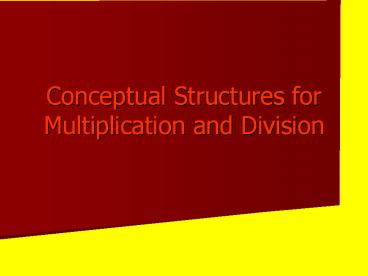Conceptual Structures for Multiplication and Division - PowerPoint PPT Presentation
1 / 8
Title:
Conceptual Structures for Multiplication and Division
Description:
... structure since it cannot be understood by counting though it is frequently used in everyday life in the context of comparing quantities or ... quantities or ... – PowerPoint PPT presentation
Number of Views:29
Avg rating:3.0/5.0
Title: Conceptual Structures for Multiplication and Division
1
Conceptual Structures for Multiplication and
Division
2
Multiplication Repeated Addition
This is the first multiplication structure to
which children should be introduced as it builds
on established understanding that children have
about addition.
2 multiplied 3 times (2 x 3)
3
Multiplication Rectangular Array
This is likely to be the second multiplication
structure to which children are introduced
formally. It provides a visual representation of
the commutative law (a x b b x a).
5 x 2
4 x 3
2 x 5
3 x 4
8 x 3
3 x 8
4
Multiplication Scaling
This is probably the hardest multiplication
structure since it cannot be understood by
counting though it is frequently used in everyday
life in the context of comparing quantities or
measurements and in calculations of the cost of
multiple purchases.
Apples 25 p.
I need to buy 5 apples, one for each day of the
week. So it will cost me 5 x 25 pence which
equals 125 pence which is 1.25!
5
Division Equal Sharing
Here we are sharing objects between a given
number of groups (for example people). This
structure is often used to explain division but
the limitation is that the divisor must always be
a whole number since to share 8 sweets by half a
person would be a nonsense.
Look Miss. Ive shared out the stars for our
group!
6
Division Equal grouping
This involves repeatedly subtracting the divisor
until there is either nothing left or there is a
remainder.
Ive given everyone 2 sweets and there is one
left over!
7
Division Ratio
This is a comparison of the scale of two
quantities or measurements in which the quotient
is regarded as the scale factor. Children often
find this structure difficult to understand and
frequently confuse it with comparison by
(subtractive) difference.
A
B
A is 2 times larger than B since 8 divided by 4
equals 2.
8
While it is important that you, as a teacher,
recognise these structures and identify them in
use within classroom activities, you should not
expect children to name them! Children will,
however, need to recognise the operation involved
(multiplication or division) in practical
contexts where the underlying structure will be
one of those described.

